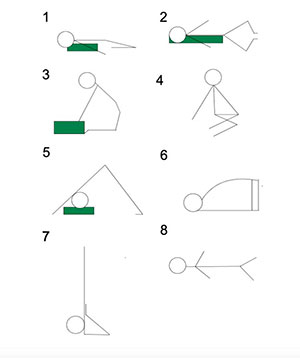
MINDBODY: YOGA
ASANAS for Lung Health

Lungs are in the limelight due to COVID-19 and its insidious attack on this vital organ of our body. COVID-19 is a primarily respiratory disease and it usually attacks the lungs first. Healthy lungs might provide resilience against this deadly virus.
The respiratory system is made up of:
- Gateway: Nostrils
- Travel passage: Airway passage
- Gas exchange: Two lungs
- Container of the lungs: Ribcage
- Muscles: Diaphragm, intercostal and accessory muscles.
The father of modern day yoga and my guru B.K.S. Iyengar mentions in his book, “Light on life” that “Extension is attention, and expansion is awareness. Extension and expansion bring space, and space brings freedom. Freedom is precision, and precision is divine. Extension is freedom, and freedom allows for relaxation. When there is relaxation in the asana, there is no fatigue. It is freedom from disease of mind and body as well.”
The path of breath – Oxygen enters the body through nose or mouth, passes the sinuses (hollow spaces in the skull that help maintain the temperature and humidity of the air we breathe). From the sinus, air passes through the trachea (windpipe) and into two bronchial tubes that carry air into each lung. The bronchial tubes split up again, up to 20-25 branches to carry air into the lobes of each lung. The right lung has three lobes while the left lung has only two, to accommodate room for the heart. The lobes are filled with small, spongy sacs called alveoli, which is where the exchange of oxygen and carbon dioxide occurs. Total surface area of the alveoli can be equal to 70 square meters or the area of a tennis court.
Effect of asanas on lungs
The top part of the lung is attached to the clavicle area (collarbone), the bottom part of the lung is resting unto your waist connected to the legs. When you lift your arms up and free the under armpit and press the legs down from waist to the floor, you are extending your side torso to stretch your lungs. Lungs cannot expand by themselves. In asanas, there is non-respiratory expansion of ribcage; this expands underlying lungs and keeps the tissue soft and elastic.
Lateral poses and twists: Gives opportunity to open segments of lung tissue. Blood tries to find alveoli to absorb oxygen and give away carbon dioxide. When squeezing one area of the lung, another area that is not being compressed can open up. The lung compensates for the side that is compressed. If you are twisting on the right, the left side of the lung opens up to its maximum blood flow in pulmonary circulation.
Trikonasana (triangle pose), Utthita parsvakonasana (lateral side stretch), chair twist (bharadvajasana).
Forward bends: Works on posterior and side lungs. Pulls abdomen in and supports natural movements of your lungs, back body expansion rotates the side lungs to move in and forward.
Uttanasana (intense forward bend), Adhomukha svanasana (downward dog), paschimottanasana (seated forward bend)
Backbends: Promotes maximal expansion of chest cavity. Help diaphragm move in a piston like function and allow the muscles of the abdomen to work better for exhalation. Diameter of the trachea has the most opening for fresh oxygen, rib cage expands to its maximum capacity and intercostal muscles lengthen.
Ustrasana (camel pose), Urdhvamukha svanasana (upward dog pose).
Inversions: Changes gravity and brings more blood to the upper regions of the lungs and more air to the basal regions of the lungs.
Setubandha sarvangasana (supported shoulder stand), sirsasana (head stand), Prasarita padottanasana (wide angle forward fold)
In times of stress, the sympathetic nervous system is dominant in the body and the chronic stress leads to imbalance and weakening of the circulatory, respiratory and lymphatic system. This weakens immunity. With steady yoga practice, the parasympathetic nervous system becomes dominant and health and vitality are restored.
Respiratory opening sequence

All asanas should be supported with props like blankets, blocks and a chair and held ideally for a minimum of 2-3 minutes or whatever possible.
- Passive back bend – Supta Virasana (supine hero pose)
- Restorative or inversion – Supta Baddha Konasana (supine butterfly pose) or Sirsasana (headstand)
- Backbends – Ustrasana (camel pose) , Urdhva Dhanurasana (bow pose)
- Twist – Bharadvajasana on mat or chair
- Forward bend – Adho Mukha Svanasana
- Backbend – Chatush Padasana (four-legged pose)
- Inversion – Salamba Sarvangasana (shoulder stand) or Halasana (plough pose)
- Resting – Savasana (corpse pose)
Bhavi Nirav is a certified Iyengar yoga teacher, Registered Dietitian/M.S., R.D., L.D., and can be reached at [email protected]